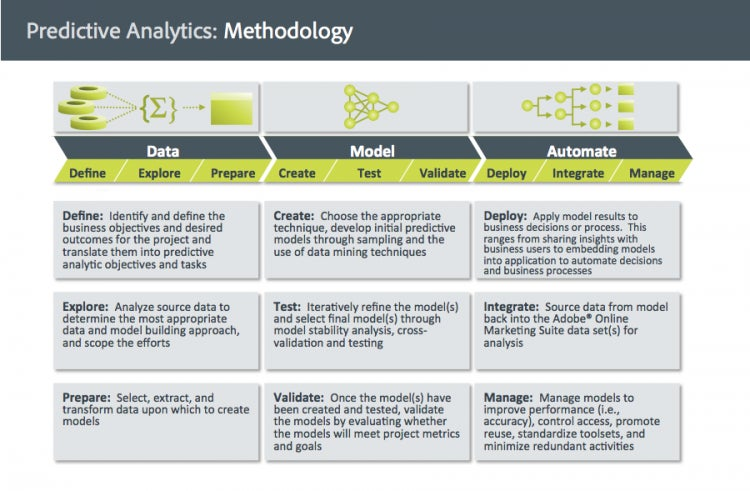Digital Marketing 101: How do I Build a Predictive Analytics Model?

Most enterprises today have goals to include Big Data or predictive analytics as part of their marketing strategy in the coming year. Unfortunately, a Gartner report showed that many people have no idea what to do with Big Data, let alone how to structure a predictive analytics program.
Predictive analytics allows us to understand the circumstances under which we engage with our customers. Or as Jeff Strickland says, “Predictive analytics is an area of data science that deals with extracting information from data and using it to predict trends and behavior patterns.”
While this all may sound intimidating, it doesn’t have to be. In fact, creating a predictive analytics program can be broken down into a series of simple, actionable steps. It all starts with one simple question: What are you trying to solve for?
Data
Define
As with any project, it’s important to start your predictive analytics program by setting table stakes. With a clearly defined set of goals, you can have your entire team on the same page regarding what you’re trying to achieve. Without this, it’s incredibly easy for people to begin pursuing their own tasks. It’s a critical exercise to sit down and determine what “success” really is for your enterprise.
Explore
Once you know what you’re trying to achieve, it’s time to explore what information, tools, and platforms you have to achieve those goals. Often, various systems do not provide data in the same format. Understanding what data is available from which sources — in precise detail — sets the foundation for what you can achieve. This is more than “we get web analytics from here.” You need to understand what metrics you get, whether you’re tracking anonymous or authenticated users, and more. Do your research to understand exactly what you have and what you may need to augment in the future.
Prepare
Once you understand where all of your data is coming from, it’s time to clean it up into a universal format. As an example, changing database field names so they all say email address (rather than various data sources with fields for e-mail, electronic mail, Email, and E-mail Address) seems like an intuitive step to some people. Yet, many organizations assume that it’s an unnecessary and time-consuming exercise. Cleaning data and making fields and mappings uniform across the platform makes it so that, when you have to do the heavy lifting of analytics, you can easily do it across your entire dataset.
Model
Create
During this initial creation phase, you’ll start to build some initial predictive models. You’ll need to select the correct technique for your organization and begin to build the models themselves. You’ll also need to choose which technology you’re going to use, how it will be coded, and how it will be managed long term. Once you get a basic model created, it’s time to test. You can always add complexity over time — this will naturally happen during testing as well as whenever you optimize the model in the future.
Test
Another stage that many think is self-explanatory, testing is one of the most important parts of building a predictive analytics program. Any model needs to be tested to make sure it is working correctly after being built. During the test phase, you are performing numerous statistical tests against the model itself to determine how ‘good’ the model is in both meeting the underlying assumptions of the model and reviewing the precision and accuracy of the predictions against a data set that was not used in the model training. This will provide you the ability to quickly give your model the ‘sniff’ test to determine its accuracy and predictive power. You may find a simple error that is easily fixed, realize you need to try another modeling technique, or even see that your data isn’t quite as clean as you thought it was. Before any launch, extensive testing needs to occur.
Validate
Once your model appears to be in working order, it’s time to take it back to the business stakeholders. It’s not unusual to have some additional queries after looking at the results. This is an iterative process; expect to loop through these six steps until you have the right goals, models, and data sources in place.
Automate
Deploy
Once everyone has finally agreed that you have the correct predictive model in place, you can deploy. In live mode, you’ll begin to get insights into your customer’s experiences and behaviors and understand more about what they’re likely to do in the future.
Integrate
Once the model is in deployment, you’ll find that predictive analytics continues to be an iterative science. You’ll begin to report on how well the model did to understand whether your assumptions hold true in the real world and whether you’re really meeting your goals for the program.
Manage
Over time, you’ll find that each month, you’ll tweak and recalibrate the models. This will allow you to continue to fine tune the predictive model and garner accurate, actionable insights. There are different levels of analytics maturity. You can’t expect to have your program running perfectly right out of the gate. Instead, you’ll have to get comfortable with error. Error will ultimately be what helps you to better understand your data and which actions lead to which results.
Following these steps will create a predictive analytics program that allows your organization to better understand your customers’ behaviors and predict what offers they may respond to best in the future. It also creates the foundation for a predictive analytics program that will grow as your organization grows.
As it continues to grow, predictive analytics has the potential to become part of everyday tasks and workflows within an organization. It will become something that we naturally consult before making any major campaign decisions. Perhaps, before long, we’ll have access to analytics in the palm of our hands — or at least on our wrists.
